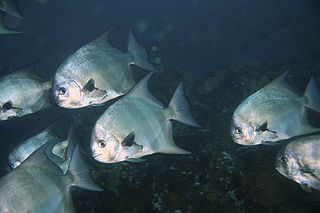
The snailfishes or sea snails, are a family of marine ray-finned fishes. These fishes make up the Liparidae, a family classified within the order Scorpaeniformes.
Bostrychus zonatus, the Barred gudgeon, is a species of fish in the family Butidae native to Irian Jaya, Indonesia and Papua New Guinea where it can be found in fresh and brackish waters. This species can reach a length of 18.5 centimetres (7.3 in) SL.
Parator zonatus, the trilobed-lip barbel, is a species of cyprinid fish found in the Zhujiang River in China and Vietnam. It is the only member of its genus.

Liparis montagui, or Montagu's seasnail, is a marine fish of the seasnail family (Liparidae). It inhabits the northeastern Atlantic, mainly around the British Isles, the North Sea, the Norwegian Sea, southern Iceland and as far north as the Barents Sea. It is a small, demersal fish, usually living between from the intertidal zone to 30 metres deep, where it hides under stones or algae. It mainly feeds on small invertebrates, such as small crabs, shrimp and amphipods. This species was described in 1804 by the Anglo-Irish writer, natural history illustrator, and amateur zoologist Edward Donovan with England given as the type locality. The specific name honours the English naturalist George Montagu who provided Donovan with an illustration and a description of this "beautiful little fish".

Liparis fabricii, commonly known as the gelatinous seasnail or gelatinous snailfish, is a benthopelagic species of snailfish from the Arctic Ocean. It has a tadpole-like body with a maximum length of about 20 cm (7.9 in). It is brown to black in coloration with a distinctive dark peritoneum. It preys on small crustaceans and marine worms. It is not commercially important, though it is a valuable food source for predatory fish and seabirds in the Arctic region.

Liparis is a large genus of snailfish from the northern hemisphere. They are very common in temperate and cold waters. Chernova (2008) has proposed that the genus should be subdivided into five subgenera: Liparis, Neoliparis, Lycocara, Careliparis, and Lyoliparis.

Liparis liparis, the common seasnail, striped seasnail or seasnail, is a small species of marine ray-finned fish belonging to the family Liparidae, the snailfishes, in the order Scorpaeniformes, the scorpionfishes and flatheads. It is found in the northeastern Atlantic Ocean where it lives on the seabed.

The Pacific spadefish is a species of fish of the family Ephippidae. It is native to the eastern Pacific, from San Diego, California to Peru, including the Galápagos Islands where it is known as Chambo.

Liparis atlanticus, the Atlantic snailfish or Atlantic seasnail, is a species of marine ray-finned fish belonging to the family Liparidae, the snailfishes. This species is found in the western Atlantic Ocean off the eastern coast of North America.

Liparis mucosus, or the slimy snailfish, is a fish from the genus Liparis. The fish can be found from intertidal areas to 15 meters in depth. In general, they are not found in tide pools. The slimy snailfish ranges in the Northeastern Pacific Ocean from Sitka, Alaska to southern British Columbia, Canada as well as to Baja California, Mexico. It grows to 2.8–5 inches.

Liparis marmoratus, or the festive snailfish, is a marine ray-finned fish from the genus Liparis. It was first described by Schmidt in 1950.
Liparis brashnikovi is a fish from the genus Liparis. The fish grows to a maximum of 15 cm. It is a marine fish that lives in the demersal zone. Distribution includes the Sea of Japan in the Northwest Pacific Ocean.
Liparis tunicatus, or the kelp snailfish, is a species of snailfish from the genus Liparis. It can be found in marine, demersal waters at a depth range from 0 to 620 m (0–2,034 ft). The kelp snailfish lives in the Arctic and Northwest Atlantic Ocean among kelp. The species is common, at least around Greenland and Franz Josef Land. A bottom feeder, it eats small crustaceans. At Franz Josef Land, it spawns in March at a depth of 6–25 m (20–82 ft), with the egg clusters attached to kelp.

Goniistius is a subgenus of marine ray-finned fishes, traditionally classified as being within the genus Cheilodactylus and belonging to the family Cheilodactylidae, known as morwongs, although this name is not unique to this family and the true taxonomic placement of this taxon requires clarification. They are found in the Pacific Ocean and southeastern Indian Ocean.

The bleeding shiner is a freshwater ray-finned minnow in the family Leuciscidae, which was recently changed to distinguish between North American and Asian minnows. It occurs in tributaries of Ozark-draining tributaries of the Missouri, and Mississippi rivers in southern Missouri and northeastern Arkansas. Its preferred habitat is rocky and sandy pools and runs of headwaters, creeks and small rivers.

The banded rudderfish, also known as the slender amberjack, banded mackerel or shark pilot, is a species of ray-finned fish from the family Carangidae, the jacks and pompanos from the western Atlantic Ocean.

The spottedtail morwong is a species of marine ray-finned fish, traditionally regarded as belonging to the family Cheilodactylidae, the members of which are commonly known as morwongs. It is found in the northwest Pacific Ocean.
Simpsonichthys zonatus is a species of killifish from the family Rivulidae. It is found in the São Francisco River basin, Brazil.

Liparis gibbus, the polka-dot snailfish, variegated snailfish or dusky snailfish, is a species of marine ray-finned fish belonging to the family Liparidae, the snailfishes. This fish is found in Arctic waters. Juveniles of the species have been found to be biofluorescent.











